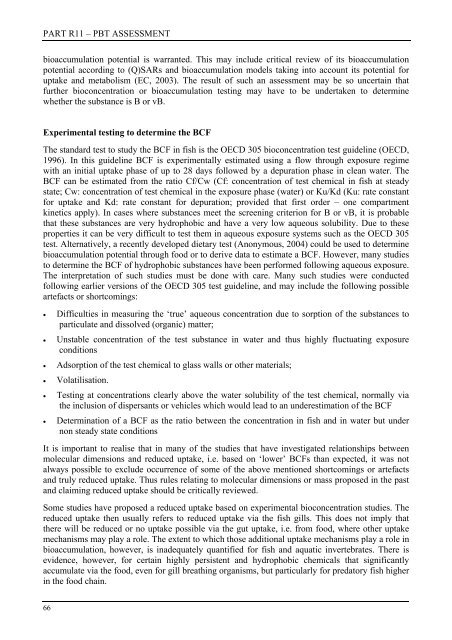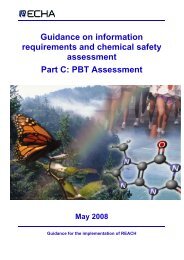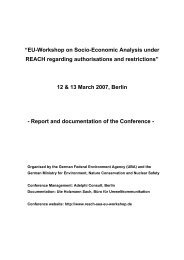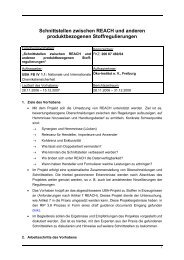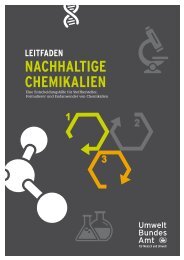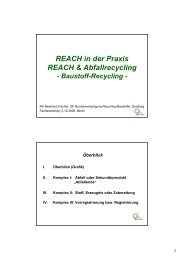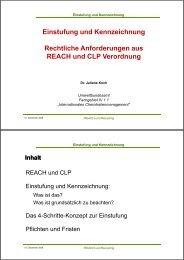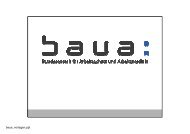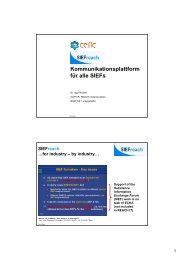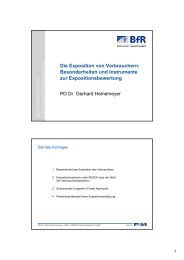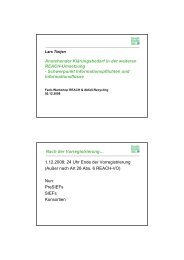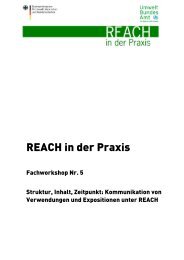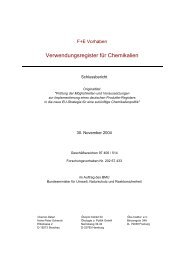PBT Assessment - REACh
PBT Assessment - REACh
PBT Assessment - REACh
You also want an ePaper? Increase the reach of your titles
YUMPU automatically turns print PDFs into web optimized ePapers that Google loves.
PART R11 – <strong>PBT</strong> ASSESSMENT<br />
bioaccumulation potential is warranted. This may include critical review of its bioaccumulation<br />
potential according to (Q)SARs and bioaccumulation models taking into account its potential for<br />
uptake and metabolism (EC, 2003). The result of such an assessment may be so uncertain that<br />
further bioconcentration or bioaccumulation testing may have to be undertaken to determine<br />
whether the substance is B or vB.<br />
Experimental testing to determine the BCF<br />
The standard test to study the BCF in fish is the OECD 305 bioconcentration test guideline (OECD,<br />
1996). In this guideline BCF is experimentally estimated using a flow through exposure regime<br />
with an initial uptake phase of up to 28 days followed by a depuration phase in clean water. The<br />
BCF can be estimated from the ratio Cf/Cw (Cf: concentration of test chemical in fish at steady<br />
state; Cw: concentration of test chemical in the exposure phase (water) or Ku/Kd (Ku: rate constant<br />
for uptake and Kd: rate constant for depuration; provided that first order – one compartment<br />
kinetics apply). In cases where substances meet the screening criterion for B or vB, it is probable<br />
that these substances are very hydrophobic and have a very low aqueous solubility. Due to these<br />
properties it can be very difficult to test them in aqueous exposure systems such as the OECD 305<br />
test. Alternatively, a recently developed dietary test (Anonymous, 2004) could be used to determine<br />
bioaccumulation potential through food or to derive data to estimate a BCF. However, many studies<br />
to determine the BCF of hydrophobic substances have been performed following aqueous exposure.<br />
The interpretation of such studies must be done with care. Many such studies were conducted<br />
following earlier versions of the OECD 305 test guideline, and may include the following possible<br />
artefacts or shortcomings:<br />
• Difficulties in measuring the ‘true’ aqueous concentration due to sorption of the substances to<br />
particulate and dissolved (organic) matter;<br />
• Unstable concentration of the test substance in water and thus highly fluctuating exposure<br />
conditions<br />
• Adsorption of the test chemical to glass walls or other materials;<br />
• Volatilisation.<br />
• Testing at concentrations clearly above the water solubility of the test chemical, normally via<br />
the inclusion of dispersants or vehicles which would lead to an underestimation of the BCF<br />
• Determination of a BCF as the ratio between the concentration in fish and in water but under<br />
non steady state conditions<br />
It is important to realise that in many of the studies that have investigated relationships between<br />
molecular dimensions and reduced uptake, i.e. based on ‘lower’ BCFs than expected, it was not<br />
always possible to exclude occurrence of some of the above mentioned shortcomings or artefacts<br />
and truly reduced uptake. Thus rules relating to molecular dimensions or mass proposed in the past<br />
and claiming reduced uptake should be critically reviewed.<br />
Some studies have proposed a reduced uptake based on experimental bioconcentration studies. The<br />
reduced uptake then usually refers to reduced uptake via the fish gills. This does not imply that<br />
there will be reduced or no uptake possible via the gut uptake, i.e. from food, where other uptake<br />
mechanisms may play a role. The extent to which those additional uptake mechanisms play a role in<br />
bioaccumulation, however, is inadequately quantified for fish and aquatic invertebrates. There is<br />
evidence, however, for certain highly persistent and hydrophobic chemicals that significantly<br />
accumulate via the food, even for gill breathing organisms, but particularly for predatory fish higher<br />
in the food chain.<br />
66


